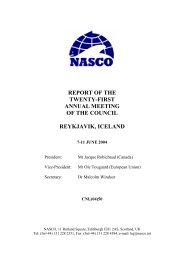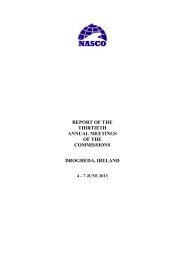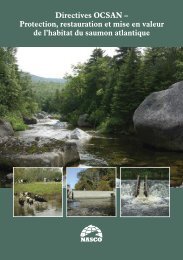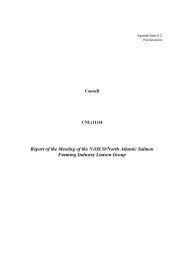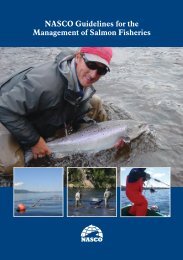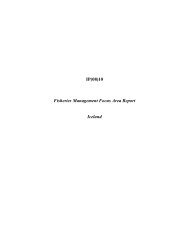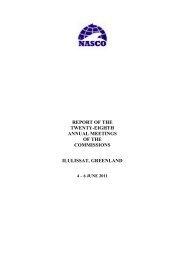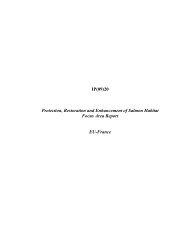Report of the 2005 ICES/NASCO Symposium on Interactions ...
Report of the 2005 ICES/NASCO Symposium on Interactions ...
Report of the 2005 ICES/NASCO Symposium on Interactions ...
Create successful ePaper yourself
Turn your PDF publications into a flip-book with our unique Google optimized e-Paper software.
NINA SPECIAL REPORT 34<br />
need for fur<str<strong>on</strong>g>the</str<strong>on</strong>g>r research <strong>on</strong> <str<strong>on</strong>g>the</str<strong>on</strong>g> factors influencing <str<strong>on</strong>g>the</str<strong>on</strong>g><br />
performance <str<strong>on</strong>g>of</str<strong>on</strong>g> hatchery fish in nature and <str<strong>on</strong>g>the</str<strong>on</strong>g> ecosystem<br />
effects <str<strong>on</strong>g>of</str<strong>on</strong>g> increasing salm<strong>on</strong> abundance in fresh and sea<br />
water.<br />
2.2 Sessi<strong>on</strong> 2: Genetic and Ecological Interacti<strong>on</strong>s<br />
and <str<strong>on</strong>g>the</str<strong>on</strong>g>ir Management<br />
This sessi<strong>on</strong> comprised twenty presentati<strong>on</strong>s. The topics<br />
addressed were modelling studies <str<strong>on</strong>g>of</str<strong>on</strong>g> genetic and<br />
ecological impacts; envir<strong>on</strong>mental impacts <str<strong>on</strong>g>of</str<strong>on</strong>g> salm<strong>on</strong><br />
farming in Chile; selecti<strong>on</strong> programmes in aquaculture; <str<strong>on</strong>g>the</str<strong>on</strong>g><br />
level and causes <str<strong>on</strong>g>of</str<strong>on</strong>g> escapes and incidence <str<strong>on</strong>g>of</str<strong>on</strong>g> escapees in<br />
<str<strong>on</strong>g>the</str<strong>on</strong>g> wild; behaviour <str<strong>on</strong>g>of</str<strong>on</strong>g> escapees; physical and biological<br />
c<strong>on</strong>tainment <str<strong>on</strong>g>of</str<strong>on</strong>g> farmed salm<strong>on</strong>; genetic impacts <str<strong>on</strong>g>of</str<strong>on</strong>g><br />
escapees; stocking programmes; striped bass/salm<strong>on</strong><br />
interacti<strong>on</strong>s and genetic stock identificati<strong>on</strong>.<br />
Modelling studies<br />
Two presentati<strong>on</strong>s reported <strong>on</strong> modelling studies. Since<br />
<str<strong>on</strong>g>the</str<strong>on</strong>g> Bath symposium <str<strong>on</strong>g>the</str<strong>on</strong>g>re has been significant progress in<br />
two areas related to genetic and ecological interacti<strong>on</strong>s.<br />
First, genetic methods to distinguish individuals and<br />
populati<strong>on</strong>s have been refined and genetic informati<strong>on</strong> <strong>on</strong><br />
both wild and farmed salm<strong>on</strong> populati<strong>on</strong>s has increased.<br />
Sec<strong>on</strong>d, studies <strong>on</strong> <str<strong>on</strong>g>the</str<strong>on</strong>g> spawning success and survival <str<strong>on</strong>g>of</str<strong>on</strong>g><br />
farmed and wild salm<strong>on</strong> and <str<strong>on</strong>g>the</str<strong>on</strong>g>ir crosses have been<br />
completed in <str<strong>on</strong>g>the</str<strong>on</strong>g> Rivers Imsa (Norway) and Burrishoole<br />
(Ireland). Data <strong>on</strong> relative fitness and spawning success <str<strong>on</strong>g>of</str<strong>on</strong>g><br />
wild and cultured salm<strong>on</strong> were used to model <str<strong>on</strong>g>the</str<strong>on</strong>g> genetic<br />
and ecological effects <str<strong>on</strong>g>of</str<strong>on</strong>g> farmed salm<strong>on</strong> <strong>on</strong> wild salm<strong>on</strong><br />
under various intrusi<strong>on</strong> scenarios. The model suggests<br />
that with a fixed intrusi<strong>on</strong> rate <str<strong>on</strong>g>of</str<strong>on</strong>g> 20% escaped farmed<br />
salm<strong>on</strong> at spawning, substantial changes take place in wild<br />
salm<strong>on</strong> populati<strong>on</strong>s within ten salm<strong>on</strong> generati<strong>on</strong>s. Low<br />
intrusi<strong>on</strong> scenarios (varying from 0 to 25% per year)<br />
suggest that farmed <str<strong>on</strong>g>of</str<strong>on</strong>g>fspring are unlikely to become<br />
established in <str<strong>on</strong>g>the</str<strong>on</strong>g> populati<strong>on</strong>, while under high intrusi<strong>on</strong><br />
scenarios (varying from 0 to 75% per year), <str<strong>on</strong>g>the</str<strong>on</strong>g> model<br />
suggests that <str<strong>on</strong>g>the</str<strong>on</strong>g> wild salm<strong>on</strong> populati<strong>on</strong>s eventually<br />
become mixtures <str<strong>on</strong>g>of</str<strong>on</strong>g> hybrid and farmed descendants. The<br />
low and high intrusi<strong>on</strong> scenarios were based <strong>on</strong> <str<strong>on</strong>g>the</str<strong>on</strong>g><br />
incidence <str<strong>on</strong>g>of</str<strong>on</strong>g> escapees found in Norwegian rivers. The<br />
model also indicated that recovery is not likely under all<br />
scenarios, even after many decades with no fur<str<strong>on</strong>g>the</str<strong>on</strong>g>r<br />
intrusi<strong>on</strong>s, and <str<strong>on</strong>g>the</str<strong>on</strong>g> authors c<strong>on</strong>cluded that fur<str<strong>on</strong>g>the</str<strong>on</strong>g>r<br />
measures to reduce escapes <str<strong>on</strong>g>of</str<strong>on</strong>g> farmed salm<strong>on</strong>, and <str<strong>on</strong>g>the</str<strong>on</strong>g>ir<br />
spawning in <str<strong>on</strong>g>the</str<strong>on</strong>g> wild, are required urgently.<br />
Populati<strong>on</strong> dynamic modelling using data <strong>on</strong> catches,<br />
returns, juvenile densities and escapements was used to<br />
estimate <str<strong>on</strong>g>the</str<strong>on</strong>g> impacts <str<strong>on</strong>g>of</str<strong>on</strong>g> marine salm<strong>on</strong> farming <strong>on</strong> survival<br />
<str<strong>on</strong>g>of</str<strong>on</strong>g> wild salm<strong>on</strong>ids using populati<strong>on</strong>s less exposed to<br />
farming as c<strong>on</strong>trols. While <str<strong>on</strong>g>the</str<strong>on</strong>g>re are significant challenges<br />
in analysing <str<strong>on</strong>g>the</str<strong>on</strong>g>se data (including data quality, a high degree<br />
<str<strong>on</strong>g>of</str<strong>on</strong>g> natural variability and missing data), impacts <strong>on</strong> <str<strong>on</strong>g>the</str<strong>on</strong>g><br />
survival <str<strong>on</strong>g>of</str<strong>on</strong>g> wild fish related to <str<strong>on</strong>g>the</str<strong>on</strong>g> scale <str<strong>on</strong>g>of</str<strong>on</strong>g> farmed fish<br />
producti<strong>on</strong> in <str<strong>on</strong>g>the</str<strong>on</strong>g> area were identified.<br />
Envir<strong>on</strong>mental impacts <str<strong>on</strong>g>of</str<strong>on</strong>g> salm<strong>on</strong> farming in Chile<br />
A review <str<strong>on</strong>g>of</str<strong>on</strong>g> <str<strong>on</strong>g>the</str<strong>on</strong>g> impacts <str<strong>on</strong>g>of</str<strong>on</strong>g> Atlantic salm<strong>on</strong> farming <strong>on</strong><br />
marine coastal ecosystems in Chile indicated that when<br />
this subject was last reviewed in 1996, <str<strong>on</strong>g>the</str<strong>on</strong>g> evidence did<br />
not suggest significant impacts. Today, <str<strong>on</strong>g>the</str<strong>on</strong>g> industry is<br />
c<strong>on</strong>sidered to be c<strong>on</strong>solidated but with potential for<br />
fur<str<strong>on</strong>g>the</str<strong>on</strong>g>r expansi<strong>on</strong> to <str<strong>on</strong>g>the</str<strong>on</strong>g> south into pristine coastal areas.<br />
After almost ten years <str<strong>on</strong>g>of</str<strong>on</strong>g> sustained growth, recent<br />
research indicates a significant loss <str<strong>on</strong>g>of</str<strong>on</strong>g> benthic biodiversity<br />
and localised changes in physico-chemical properties <str<strong>on</strong>g>of</str<strong>on</strong>g><br />
sediments in areas with salm<strong>on</strong>id farms. The presence <str<strong>on</strong>g>of</str<strong>on</strong>g><br />
farms was also found to increase <str<strong>on</strong>g>the</str<strong>on</strong>g> density <str<strong>on</strong>g>of</str<strong>on</strong>g><br />
din<str<strong>on</strong>g>of</str<strong>on</strong>g>lagellates and <str<strong>on</strong>g>the</str<strong>on</strong>g> abundance <str<strong>on</strong>g>of</str<strong>on</strong>g> omnivorous and<br />
carri<strong>on</strong>-feeding sea birds. Farmed salm<strong>on</strong> escapees are<br />
also a c<strong>on</strong>cern in Chile. The authors c<strong>on</strong>cluded that it is<br />
urgent that an ecosystem approach is implemented to<br />
assess and manage all impacts from salm<strong>on</strong>id farming in<br />
Chile.<br />
Selecti<strong>on</strong> programmes in aquaculture<br />
In a review <str<strong>on</strong>g>of</str<strong>on</strong>g> <str<strong>on</strong>g>the</str<strong>on</strong>g> history <str<strong>on</strong>g>of</str<strong>on</strong>g> genetic research within <str<strong>on</strong>g>the</str<strong>on</strong>g><br />
aquaculture industry it was reported that <str<strong>on</strong>g>the</str<strong>on</strong>g> goal within<br />
<str<strong>on</strong>g>the</str<strong>on</strong>g> Norwegian aquaculture industry is domesticati<strong>on</strong> to<br />
improve producti<strong>on</strong> performance by reducing mortality<br />
and increasing growth rate. Both mass selecti<strong>on</strong> (selecting<br />
individual fish out <str<strong>on</strong>g>of</str<strong>on</strong>g> <str<strong>on</strong>g>the</str<strong>on</strong>g> entire populati<strong>on</strong>) and family<br />
selecti<strong>on</strong> (selecting particular families out <str<strong>on</strong>g>of</str<strong>on</strong>g> <str<strong>on</strong>g>the</str<strong>on</strong>g><br />
populati<strong>on</strong>) are used but less than 5% <str<strong>on</strong>g>of</str<strong>on</strong>g> fish stocked in<br />
aquaculture originate from selecti<strong>on</strong> programmes. Most<br />
<str<strong>on</strong>g>of</str<strong>on</strong>g> <str<strong>on</strong>g>the</str<strong>on</strong>g> genetic improvement is based <strong>on</strong> mass selecti<strong>on</strong><br />
without any pedigree informati<strong>on</strong>. Mass selecti<strong>on</strong> can <strong>on</strong>ly<br />
be used to improve traits recorded <strong>on</strong> breeding<br />
candidates (e.g. growth rate, shape, colour, grilse or multisea-winter<br />
fish) whereas family breeding is required to<br />
improve meat and carcass quality and resistance to<br />
diseases and parasites. In future, focus areas for breeding<br />
programmes will include use <str<strong>on</strong>g>of</str<strong>on</strong>g> selective breeding to<br />
develop strains <str<strong>on</strong>g>of</str<strong>on</strong>g> salm<strong>on</strong> capable <str<strong>on</strong>g>of</str<strong>on</strong>g> utilizing vegetable<br />
oils, to develop more robust strains with high survival and<br />
good producti<strong>on</strong> performance in farming and to reduce<br />
<str<strong>on</strong>g>the</str<strong>on</strong>g> fitness <str<strong>on</strong>g>of</str<strong>on</strong>g> escapees for survival in <str<strong>on</strong>g>the</str<strong>on</strong>g> wild.<br />
7



